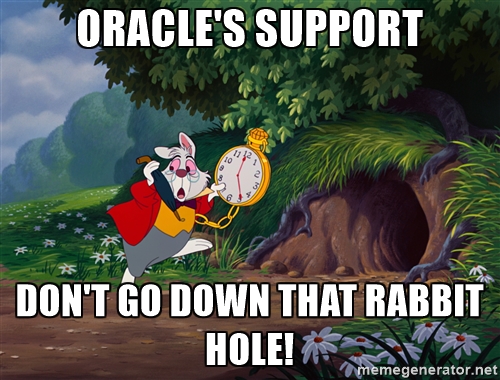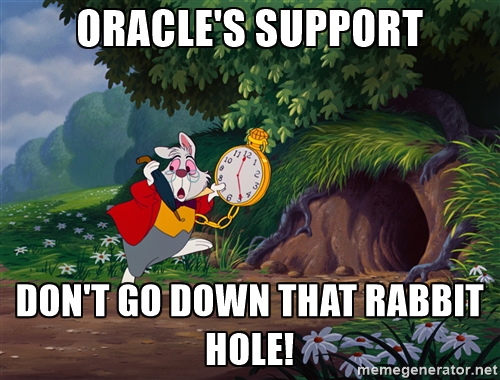Tag Archives: Oracle
How to extend the “root” Filesystem size in Exalytics x5-4 ?
Ques) How to extend the "root" Filesystem size in Exalytics x5-4 ?
Ans) Rather than extending root partition,suggestion is to create another extended partition , create file system and mount it on the directory which will save more files.Generally 3 GB is more than enough for OVM and Oracle doesn't recommend customer to save much files on OVM filesystem.If logs are taking more space , then suggestion is to save those logs in some remote server.
This is unsupported scenario.Increasing the root partition is little risky , as it involves deleting the partition table and recreating with larger sizes.In place of that Oracle suggest to checketbackup client installation, if it is possible to install in some other directory.
OBIEE 11.1.1.7: Is It Still Supported?

Last week, during a quiet working morning, my colleague Robin Moffatt sent me a link that changed my working focus for few hours.
The link was to "OBIEE 11g: Required and Recommended Bundle Patches and Patch Sets (Doc ID 1488475.1)", a document containing the latest bundle patch (patch set) available for every major OBIEE release.
He spotted that for the first time, the new bundle patch released on 17 Jan 2017 was for OBIEE 11.1.1.9 only, with the latest patch for 11.1.1.7 being the one previously released on 18 Oct 2016.
Moreover there is a clear statement in the document saying that is necessary to be at least on the 11.1.1.7.151020 patch-set or upgrade to 11.1.1.9 (or 12c) in order to receive continued Error Correction Support.
Questions became then naturally:
- Is OBIEE 11.1.1.7 still fully supported?
- What is Error Correction Support?
- How does Oracle Support Work?
- How can I verify if my software is supported and when the support ends?

With those questions in mind, I started my wonderful journey in understanding the Oracle support, if you want be my guests then sit down, take a coffee (espresso please) and enjoy the trip.
Understanding OBIEE Oracle Support
Disclaimer: All the information and date mentioned in the post reflect the situation as of the post publication date, Oracle may change them in future. Oracle support documents mentioned in this post should be directly taken as reference. The documents linked below are mostly regarding OBIEE, for other products please visit Oracle's support website.
Understanding Oracle's support requires patience and the right set of documents, with the main two being:
- Lifetime Support Policy: provides the announcements, dates and exceptions for the end of Premier, Extended and Sustaining Support. The detail of the Lifetime Support Policy is by product e.g OBIEE 11.1.1.*.
- Error Correction Support Policy: provides details regarding the end of bug correction support per single release (e.g. 11.1.1.7). For OBIEE 12c the Error Correction Support document is merged in the Fusion Middleware document.
The combined information contained in these two sources should be used to determine the status of a specific Oracle's software version.
Oracle's Support Phases
The two documents listed above provide a good starting point, but what do "Premier", "Extended", "Sustaining" and "Error Correction" Support mean?
Doc ID 1664916.1 and Lifetime Support Policy page provide a detailed explanation.
The "Lifetime Support Policy" defines the three main phases for each product (e.g. OBI 11g):
- Premier Support: is in the first 5 years (however this timeframe could be changed) from General Availability of a product, during this period bundle patches are released providing error correction and new features with certification for most Oracle or third party support.
- Extended Support: almost all the benefits of Premier Support can be extended by another three years after its end with an additional fee.
- Sustaining Support: after the end of Premier Support, this option (requiring an additional fee) provides a limited support on existing product bugs but no new developments (e.g. a certified mechanism of connecting OBIEE 10g to Impala); can be extended for an unlimited amount of time.
The first two phases are also considered Error Correction Support since are the only two where new bug/security related patches are provided. After the end of Error Correction Phase no more patches will be released for a certain product.
Applying the Lifetime Support Policy to OBIEE 11.1.1.* based on Oracle's documentation the following is obtained.

As mentioned before, this is a guideline for the whole OBIEE 11.1.1.* set of products, so how can I determine the end of support for a certain release?
Usually the answer to this question is defined by
- The end of the Premier/Extended Support if the release you're checking is the latest available of a product
- The end of the release's Grace period: if a newer release is available. The grace period, mentioned in Doc ID 944866.1 is the period of time (usually one year) following the release of a patch set in which Oracle provides fixes for both the new and previous patch set. The grace period is calculated based on the availability of the following release. E.g. since OBIEE 11.1.1.1.9 was released in May 2015, the grace period for 11.1.1.7 should be ended in May 2016. There are however exceptions where the grace period and related error correction support is extented, like for the 11.1.1.7 which now is extended until December 2018 as per OBIEE Error Correction Support document.
The following graph shows the error correction support phases for OBIEE 11.1.1.7.

What Does This Mean For OBIEE 11.1.1.7?
As stated above OBIEE 11.1.1.7 is still in its grace period meaning that bundle patches and security fixes will still be released when needed until Dec-2018.
Is OBIEE 11.1.1.7 Still The Right Choice?
If all you need is support for your existing and working environment having the latest bundle patch, then yes, you're fine and you'll be until December 2018.
But we all know how long an upgrade takes from planning to the actual execution and testing. Probably you don't want to wait until the end of next year having to rush for the upgrade because your system is getting out of support.

We at Rittman Mead are in favour of a smart upgrade planning and with our fixed cost upgrade process can take care of it while you keep focusing on what matters in your company.
Upgrading
As suggested by Oracle's document there are two options: migrate to the latest 11g release (11.1.1.9) or 12c. Both are valid options - 11.1.1.9 has another few years of premier support, with end of error correction support targeted for Dec-2021 as stated in Oracle's Doc 1664916.1.
If you are opting for the migration, choosing the target release should be based on the features you aim to get and the version stability plan: some options like Visual Analyzer, Advanced Analytics, and Data Mashups are only available on 12c which is the version currently developed, while 11g is on its way out. These points are discussed in more detail below.
Upgrading to OBIEE 11.1.1.9
The migration to 11.1.1.9 might seem easier and it could be done in-place. However it still requires database schema changes, moreover an in-place upgrade has associated risk of having unavailable live environments until all issues are fixed; risk that can be mitigated with an out-of-place upgrade.
You can find a list of 11.1.1.9 new features for end users and system admins in our blog.
Finally, if you migrate to 11.1.1.9, the end of its error correction support in Dec-2021 forces the next milestone in your upgrade path.
Upgrading to OBIEE 12c
On the other hand the migration to OBIEE 12c (with the 12.2.1.2.0 being the latest available as of now) is completely an out-of-place process. There is a requirement on the source 11g version meaning that if you are currently on a pre-11.1.1.7 version, you'll first need to perform a migration to 11.1.1.7 or 11.1.1.9 and then to 12c.
The upgrade process is smooth, with a dedicated upgrade tool taking care of moving the catalog, RPD and part of the security and a Baseline Validation Tool helping in automating the testing.
OBIEE 12c includes several new features with new connectors to big data world that will increase over time and the new options like Visual Analyzer and Data Mashup providing great functionalities directly in the hands of end users.
Check out our 12c migration case study presented at UKOUG!
Rittman Mead Can Help!
Unsure about the support status of your current system and the risks related? With our experience we can help you plan a migration roadmap!
A migration is not a quick process, it needs to be understood and planned correctly, the following are just some examples of our pre-migration activities with clients.
Worried about migrating?
We can advice about best installation/migration processes and the benefits of such upgrades. We can also help you implementing the processes during the migration phase.
Unsure about server capacity?
We can help estimating server sizing based on the number of active users and the enabled features. Our Performance Analytics Service can help understanding and solving bottlenecks.
Unsure about impact on BAU activities?
Our migration approach reduces the Code Freeze time to a minimum; the time to swap between versions in the production environment can also be minimised.
Uncertain about timings?
We can help you estimating effort and plans for a successful upgrade based on our experience.
Once the migration in planned, we can implement it for you or assist and support your team! Let us help you!
My Oracle Support (MOS) 17.1 Release

The My Oracle Support (MOS) portal has a quarterly release and MOS 17.1 was just released on January 20, 2017. See the following documents for detailed information:
My Oracle Support Resource Center (Doc ID 873313.1)
- What's New: Release Notes, Browser Support, Supported Languages, and My Oracle Support FAQ
- Key Things to Know: Support Tools and Resources, Get Proactive, and How to Work Effectively with Support and Oracle Best Practices
- Test your Knowledge: Portals and Support Tools Expertise. Test Your Knowledge and Get Support Accredited
My Oracle Support Release Notes (Doc ID 780132.5)
- Release Notes: New features, bug fixes, and known issues for My Oracle Support release 17.1
- MOS FAQs: General information about My Oracle Support not contained in the release notes
Analyse Your Data on the Go with Oracle Synopsis App

How many times did you receive an email on your phone with an Excel or CSV attachment you wanted to analyse immediately in an app on your mobile, without having to wait until you reach the laptop? Not only viewing raw numbers but also creating graphs and summaries with the possibility to share the end result with your colleagues?

Your prayers have been answered with the recent release from Oracle of Oracle Synopsis. This is a new mobile app available for Android devices (an iOS version coming soon) that enables building data analyses on the go by interacting with data directly on the smartphone/tablet. It is a free application that doesn't require any OBIEE backend or additional licensing.
Happy to announce that we have launched Synopsis on Android. Now go analyze your data. https://t.co/tAxCrz4RAY pic.twitter.com/JT6dHMKgVu
— BI Mobile Labs (@bimobilelabs) December 21, 2016
Oracle's mobile ecosystem so far has been represented by Oracle BI Mobile HD: an app available since several years, requiring an additional license, which focused on the visualization of OBIEE's pre-built content like dashboard, analysis or alerts. The main limitation of BI Mobile HD is that all content must be created upfront in a computer browser in order to be accessed by the application, no "analysis" option was available other than predefined drilling or navigation capabilities.
Synopsis extends Oracle's mobile ecosystem by adding an app capable of analysing data on the go, interacting directly with files on the phone/tablet in a visual and intuitive way.
Let’s have a look at how Synopsis works. For my test I'll use the Federal U.S. Electric Utility Companies and Rates data coming from en.openei.org.
I first downloaded the CSV file in my phone, then opened the Oracle Synopsis App and selected the file from the "Downloads" folder.

By default, just by opening the file with Synopsis app, I get a project named as the source file (iouzipcodes2011) showing a bar chart of ZIP by UTILITY_NAME. I'm able to switch the coordinates of the graph by either changing the dimension of the X-axis or the measure on the Y-axis by selecting another option from the sections on top and bottom of the graph respectively.

The default graphs are provided just by opening the file, without having to define any measure or dimension.
The question now is: What am I looking at? How do I change the default behaviour?
I can get an idea about what Synopsis is doing by clicking on the project title itself. By default the application associates all text columns to dimensions and all numeric columns to measures, aggregating them with SUM. I can however change the default behaviour by:
- Changing the aggregation method for the measures, possible alternatives are Average and Count
- Changing the text and numbers (dimension and metrics) assignments by clicking on the cog icon and accessing the related screen
- Hide a column by just tapping on the column name (in the grey box shown in the image below), a
linewill be shown on top the hidden column name.

Measures format can be changed just by sliding the related number tile and setting decimals, currency, percentage format among others.

When clicking on a measure (e.g. ind_rate), a list of graphs, one per dimension, is presented. The type of graphs depends by the attribute type (bar for a text, line trend for a date) and cardinality (a donut is presented when the number of distinct value for an attribute is shown).

I can however change the graph type by clicking on it. There are multiple options:
- One or more metrics can be added and filters can be applied
- Attributes can be added and filters can be applied
- The graph type can be changed

An image of the resulting graph can then be easily sent via mail by clicking on 
When clicking on padlock icon projects are secured with the fingertip sensor. This option is enabled only in mobile devices supporting the fingertip recognition.

Projects can be exported: a .syn file will be created containing both data and metadata. The project file can then be shared and reopened with the Synopsis app in other mobiles. In this first release is not possible to share projects between Synopsis and other tools like Visual Analyzer or Data Visualization Desktop but it’s an obvious enhancement that one could imagine Oracle considering for the future.
A list of global settings is also available in order to change import settings like blank cells management and CSV delimiter.

Be aware that Synopsis requires the Excel (or CSV) file to be in a pure tabular form; extra heading rows or collapsed cells will prevent Synopsis from parsing it. On top of this, in order for it to work at least one numeric and one text column are needed.
Conclusion
Oracle Synopsis is a great addition to Oracle's mobile offering. It provides an app capable of analysing data on the go in a very visual and intuitive way. So far only CSV and Excel files are supported but my guess is that it will soon be possible to interface to a lot of other applications especially in the Cloud. And - it’s free!


